INFINITI Q50 2014 Owner's Manual
Manufacturer: INFINITI, Model Year: 2014, Model line: Q50, Model: INFINITI Q50 2014Pages: 394, PDF Size: 1.99 MB
Page 351 of 394

8-34Maintenance and do-it-yourself
SDI1607
Example
*2TIN (Tire Identification Number)
for a new tire (example: DOT XX XX
XXX XXXX)
1.DOT: Abbreviation for the “Depart-
ment of Transportation”. The sym-
bol can be placed above, below or
to the left or right of the Tire
Identification Number.
2.Two-digit code: Manufacturer’ s
identification mark
3.Two-digit code: Tire size
4.Three-digit code: Tire type code
(Optional)
5.Three-digit code: Date of Manu-
facture
6.Four numbers represent the week
and year the tire was built. For
example, the numbers 3103
means the 31st week of 2003. If
these numbers are missing, then
look on the other sidewall of the
tire.
*3Tire ply composition and material
The number of layers or plies of
rubber-coated fabric in the tire.
Tire manufacturers also must indi-
cate the materials in the tire, which
include steel, nylon, polyester, and
others.
*4Maximum permissible inflation
pressure
This number is the greatest amount
of air pressure that should be put in
the tire. Do not exceed the maximum permissible inflation pressure.
*5Maximum load rating
This number indicates the maximum
load in kilograms and pounds that
can be carried by the tire. When
replacing the tires on the vehicle,
always use a tire that has the same
load rating as the factory installed
tire.
*6Term of “tubeless” or“tube type”
Indicates whether the tire requires an
inner tube (“ tube type”) or not
(“tubeless”).
*7The word “radial”
The word “radial”is shown, if the tire
has radial structure.
*8Manufacturer or brand name
Manufacturer or brand name is
shown.
Other tire-related terminology:
In addition to the many terms that
are defined throughout this section,
Page 352 of 394
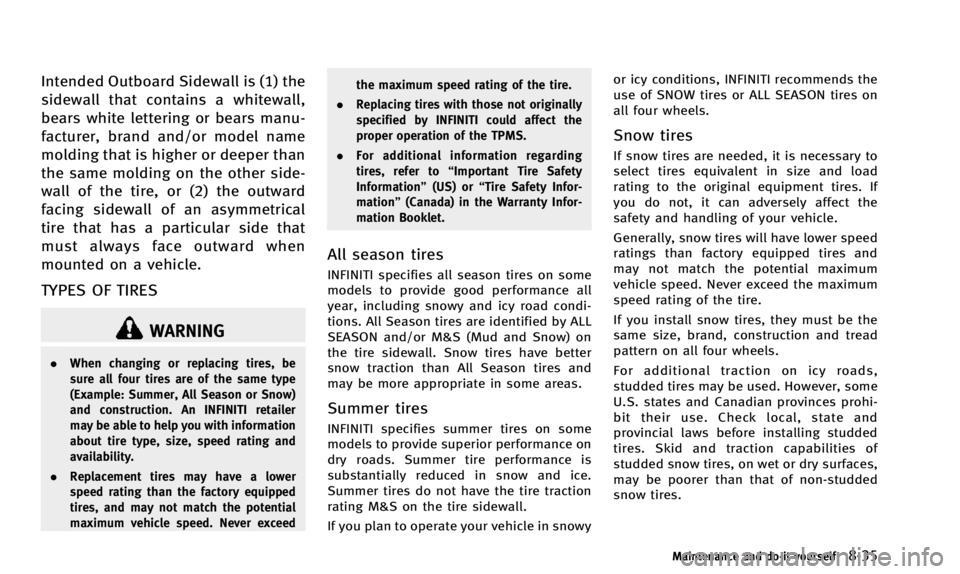
Intended Outboard Sidewall is (1) the
sidewall that contains a whitewall,
bears white lettering or bears manu-
facturer, brand and/or model name
molding that is higher or deeper than
the same molding on the other side-
wall of the tire, or (2) the outward
facing sidewall of an asymmetrical
tire that has a particular side that
must always face outward when
mounted on a vehicle.
TYPES OF TIRES
WARNING
.When changing or replacing tires, be
sure all four tires are of the same type
(Example: Summer, All Season or Snow)
and construction. An INFINITI retailer
may be able to help you with information
about tire type, size, speed rating and
availability.
. Replacement tires may have a lower
speed rating than the factory equipped
tires, and may not match the potential
maximum vehicle speed. Never exceed the maximum speed rating of the tire.
. Replacing tires with those not originally
specified by INFINITI could affect the
proper operation of the TPMS.
. For additional information regarding
tires, refer to “Important Tire Safety
Information” (US) or“Tire Safety Infor-
mation” (Canada) in the Warranty Infor-
mation Booklet.
All season tires
INFINITI specifies all season tires on some
models to provide good performance all
year, including snowy and icy road condi-
tions. All Season tires are identified by ALL
SEASON and/or M&S (Mud and Snow) on
the tire sidewall. Snow tires have better
snow traction than All Season tires and
may be more appropriate in some areas.
Summer tires
INFINITI specifies summer tires on some
models to provide superior performance on
dry roads. Summer tire performance is
substantially reduced in snow and ice.
Summer tires do not have the tire traction
rating M&S on the tire sidewall.
If you plan to operate your vehicle in snowy or icy conditions, INFINITI recommends the
use of SNOW tires or ALL SEASON tires on
all four wheels.
Snow tires
If snow tires are needed, it is necessary to
select tires equivalent in size and load
rating to the original equipment tires. If
you do not, it can adversely affect the
safety and handling of your vehicle.
Generally, snow tires will have lower speed
ratings than factory equipped tires and
may not match the potential maximum
vehicle speed. Never exceed the maximum
speed rating of the tire.
If you install snow tires, they must be the
same size, brand, construction and tread
pattern on all four wheels.
For additional traction on icy roads,
studded tires may be used. However, some
U.S. states and Canadian provinces prohi-
bit their use. Check local, state and
provincial laws before installing studded
tires. Skid and traction capabilities of
studded snow tires, on wet or dry surfaces,
may be poorer than that of non-studded
snow tires.
Maintenance and do-it-yourself8-35
Page 353 of 394
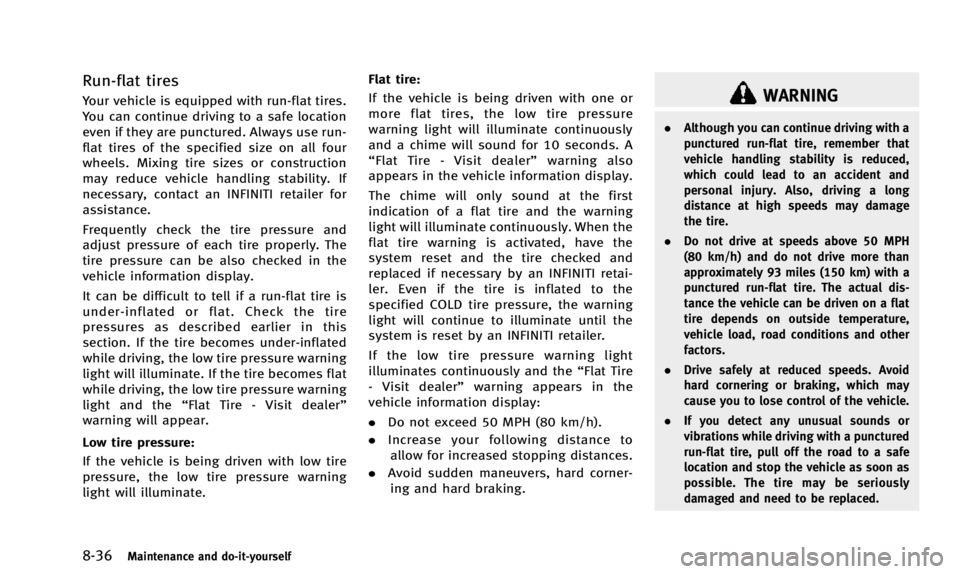
8-36Maintenance and do-it-yourself
Run-flat tires
Your vehicle is equipped with run-flat tires.
You can continue driving to a safe location
even if they are punctured. Always use run-
flat tires of the specified size on all four
wheels. Mixing tire sizes or construction
may reduce vehicle handling stability. If
necessary, contact an INFINITI retailer for
assistance.
Frequently check the tire pressure and
adjust pressure of each tire properly. The
tire pressure can be also checked in the
vehicle information display.
It can be difficult to tell if a run-flat tire is
under-inflated or flat. Check the tire
pressures as described earlier in this
section. If the tire becomes under-inflated
while driving, the low tire pressure warning
light will illuminate. If the tire becomes flat
while driving, the low tire pressure warning
light and the“Flat Tire - Visit dealer”
warning will appear.
Low tire pressure:
If the vehicle is being driven with low tire
pressure, the low tire pressure warning
light will illuminate. Flat tire:
If the vehicle is being driven with one or
more flat tires, the low tire pressure
warning light will illuminate continuously
and a chime will sound for 10 seconds. A
“ Flat Tire - Visit dealer” warning also
appears in the vehicle information display.
The chime will only sound at the first
indication of a flat tire and the warning
light will illuminate continuously. When the
flat tire warning is activated, have the
system reset and the tire checked and
replaced if necessary by an INFINITI retai-
ler. Even if the tire is inflated to the
specified COLD tire pressure, the warning
light will continue to illuminate until the
system is reset by an INFINITI retailer.
If the low tire pressure warning light
illuminates continuously and the “Flat Tire
- Visit dealer” warning appears in the
vehicle information display:
. Do not exceed 50 MPH (80 km/h).
. Increase your following distance to
allow for increased stopping distances.
. Avoid sudden maneuvers, hard corner-
ing and hard braking.WARNING
. Although you can continue driving with a
punctured run-flat tire, remember that
vehicle handling stability is reduced,
which could lead to an accident and
personal injury. Also, driving a long
distance at high speeds may damage
the tire.
. Do not drive at speeds above 50 MPH
(80 km/h) and do not drive more than
approximately 93 miles (150 km) with a
punctured run-flat tire. The actual dis-
tance the vehicle can be driven on a flat
tire depends on outside temperature,
vehicle load, road conditions and other
factors.
. Drive safely at reduced speeds. Avoid
hard cornering or braking, which may
cause you to lose control of the vehicle.
. If you detect any unusual sounds or
vibrations while driving with a punctured
run-flat tire, pull off the road to a safe
location and stop the vehicle as soon as
possible. The tire may be seriously
damaged and need to be replaced.
Page 354 of 394
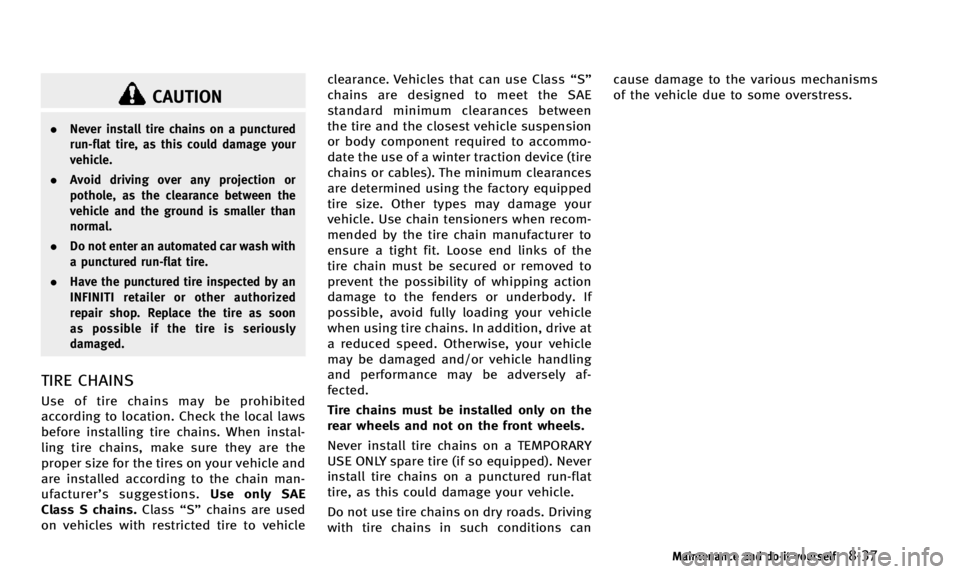
CAUTION
.Never install tire chains on a punctured
run-flat tire, as this could damage your
vehicle.
. Avoid driving over any projection or
pothole, as the clearance between the
vehicle and the ground is smaller than
normal.
. Do not enter an automated car wash with
a punctured run-flat tire.
. Have the punctured tire inspected by an
INFINITI retailer or other authorized
repair shop. Replace the tire as soon
as possible if the tire is seriously
damaged.
TIRE CHAINS
Use of tire chains may be prohibited
according to location. Check the local laws
before installing tire chains. When instal-
ling tire chains, make sure they are the
proper size for the tires on your vehicle and
are installed according to the chain man-
ufacturer’ s suggestions. Use only SAE
Class S chains. Class“S”chains are used
on vehicles with restricted tire to vehicle clearance. Vehicles that can use Class
“S”
chains are designed to meet the SAE
standard minimum clearances between
the tire and the closest vehicle suspension
or body component required to accommo-
date the use of a winter traction device (tire
chains or cables). The minimum clearances
are determined using the factory equipped
tire size. Other types may damage your
vehicle. Use chain tensioners when recom-
mended by the tire chain manufacturer to
ensure a tight fit. Loose end links of the
tire chain must be secured or removed to
prevent the possibility of whipping action
damage to the fenders or underbody. If
possible, avoid fully loading your vehicle
when using tire chains. In addition, drive at
a reduced speed. Otherwise, your vehicle
may be damaged and/or vehicle handling
and performance may be adversely af-
fected.
Tire chains must be installed only on the
rear wheels and not on the front wheels.
Never install tire chains on a TEMPORARY
USE ONLY spare tire (if so equipped). Never
install tire chains on a punctured run-flat
tire, as this could damage your vehicle.
Do not use tire chains on dry roads. Driving
with tire chains in such conditions can cause damage to the various mechanisms
of the vehicle due to some overstress.
Maintenance and do-it-yourself8-37
Page 355 of 394
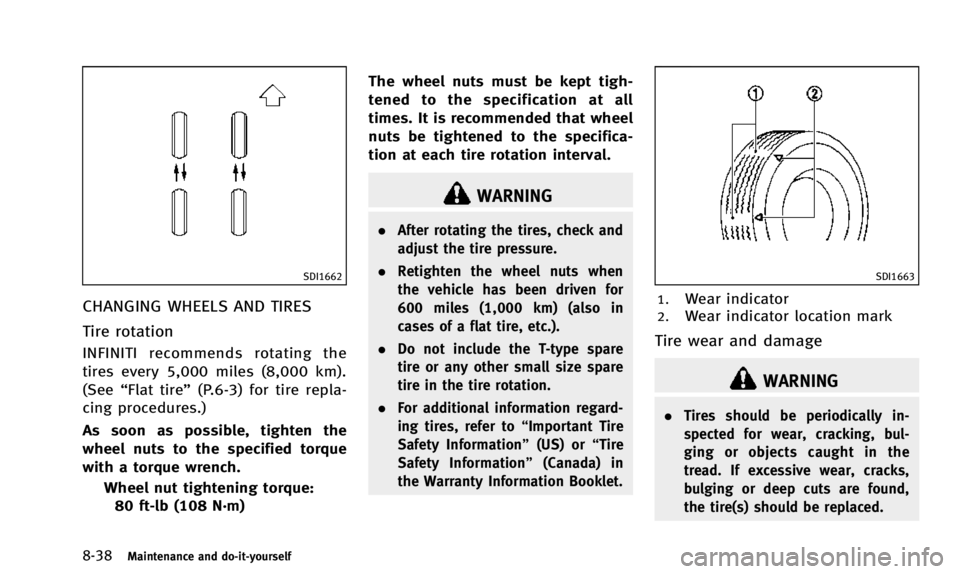
8-38Maintenance and do-it-yourself
SDI1662
CHANGING WHEELS AND TIRES
Tire rotation
INFINITI recommends rotating the
tires every 5,000 miles (8,000 km).
(See“Flat tire” (P.6-3) for tire repla-
cing procedures.)
As soon as possible, tighten the
wheel nuts to the specified torque
with a torque wrench.
Wheel nut tightening torque:80 ft-lb (108 N·m) The wheel nuts must be kept tigh-
tened to the specification at all
times. It is recommended that wheel
nuts be tightened to the specifica-
tion at each tire rotation interval.
WARNING
.
After rotating the tires, check and
adjust the tire pressure.
. Retighten the wheel nuts when
the vehicle has been driven for
600 miles (1,000 km) (also in
cases of a flat tire, etc.).
. Do not include the T-type spare
tire or any other small size spare
tire in the tire rotation.
. For additional information regard-
ing tires, refer to “Important Tire
Safety Information ”(US) or “Tire
Safety Information ”(Canada) in
the Warranty Information Booklet.
SDI1663
1.Wear indicator
2.Wear indicator location mark
Tire wear and damage
WARNING
. Tires should be periodically in-
spected for wear, cracking, bul-
ging or objects caught in the
tread. If excessive wear, cracks,
bulging or deep cuts are found,
the tire(s) should be replaced.
Page 356 of 394
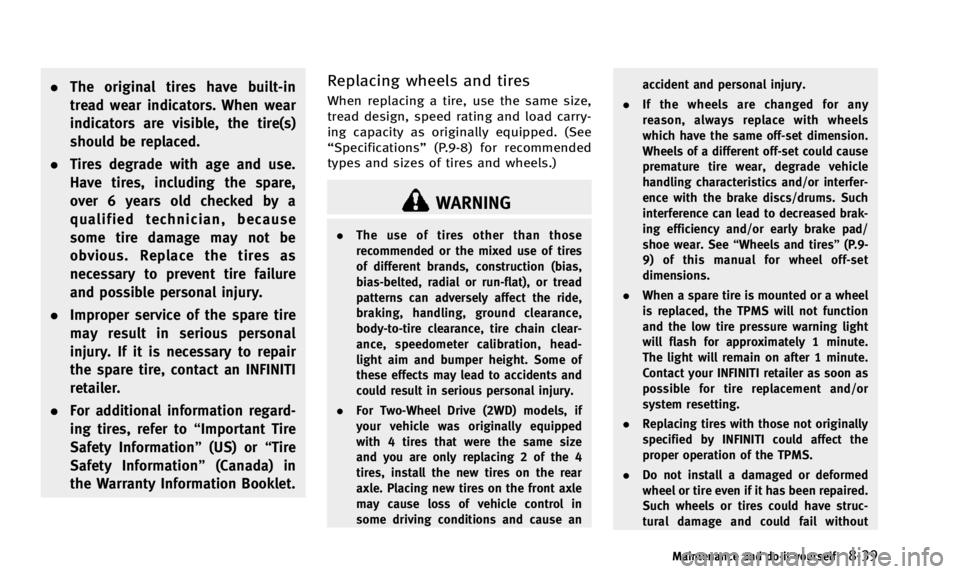
.The original tires have built-in
tread wear indicators. When wear
indicators are visible, the tire(s)
should be replaced.
. Tires degrade with age and use.
Have tires, including the spare,
over 6 years old checked by a
qualified technician, because
some tire damage may not be
obvious. Replace the tires as
necessary to prevent tire failure
and possible personal injury.
. Improper service of the spare tire
may result in serious personal
injury. If it is necessary to repair
the spare tire, contact an INFINITI
retailer.
. For additional information regard-
ing tires, refer to “Important Tire
Safety Information ”(US) or “Tire
Safety Information ”(Canada) in
the Warranty Information Booklet.Replacing wheels and tires
When replacing a tire, use the same size,
tread design, speed rating and load carry-
ing capacity as originally equipped. (See
“Specifications” (P.9-8) for recommended
types and sizes of tires and wheels.)
WARNING
. The use of tires other than those
recommended or the mixed use of tires
of different brands, construction (bias,
bias-belted, radial or run-flat), or tread
patterns can adversely affect the ride,
braking, handling, ground clearance,
body-to-tire clearance, tire chain clear-
ance, speedometer calibration, head-
light aim and bumper height. Some of
these effects may lead to accidents and
could result in serious personal injury.
. For Two-Wheel Drive (2WD) models, if
your vehicle was originally equipped
with 4 tires that were the same size
and you are only replacing 2 of the 4
tires, install the new tires on the rear
axle. Placing new tires on the front axle
may cause loss of vehicle control in
some driving conditions and cause an accident and personal injury.
. If the wheels are changed for any
reason, always replace with wheels
which have the same off-set dimension.
Wheels of a different off-set could cause
premature tire wear, degrade vehicle
handling characteristics and/or interfer-
ence with the brake discs/drums. Such
interference can lead to decreased brak-
ing efficiency and/or early brake pad/
shoe wear. See “Wheels and tires” (P.9-
9) of this manual for wheel off-set
dimensions.
. When a spare tire is mounted or a wheel
is replaced, the TPMS will not function
and the low tire pressure warning light
will flash for approximately 1 minute.
The light will remain on after 1 minute.
Contact your INFINITI retailer as soon as
possible for tire replacement and/or
system resetting.
. Replacing tires with those not originally
specified by INFINITI could affect the
proper operation of the TPMS.
. Do not install a damaged or deformed
wheel or tire even if it has been repaired.
Such wheels or tires could have struc-
tural damage and could fail without
Maintenance and do-it-yourself8-39
Page 357 of 394
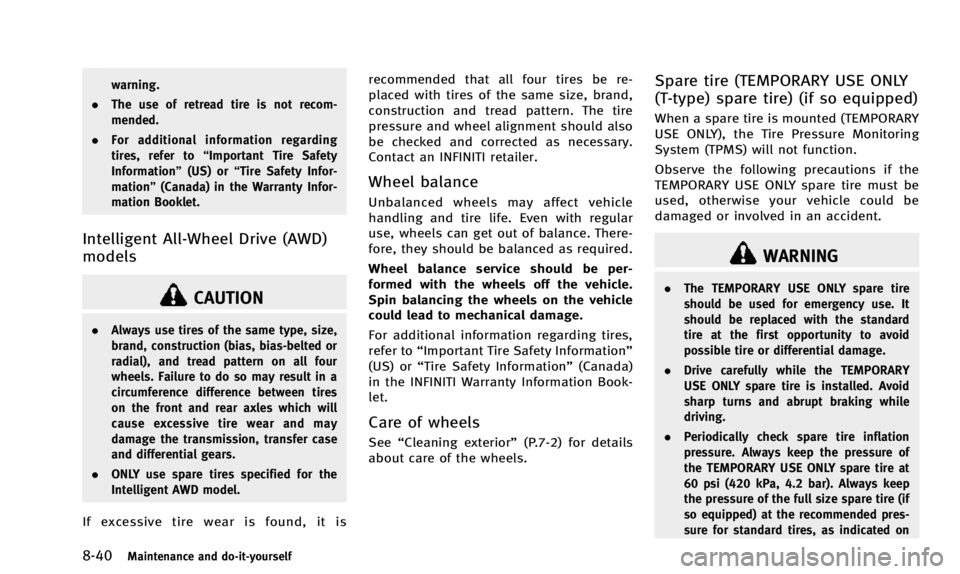
8-40Maintenance and do-it-yourself
warning.
. The use of retread tire is not recom-
mended.
. For additional information regarding
tires, refer to “Important Tire Safety
Information” (US) or“Tire Safety Infor-
mation” (Canada) in the Warranty Infor-
mation Booklet.
Intelligent All-Wheel Drive (AWD)
models
CAUTION
. Always use tires of the same type, size,
brand, construction (bias, bias-belted or
radial), and tread pattern on all four
wheels. Failure to do so may result in a
circumference difference between tires
on the front and rear axles which will
cause excessive tire wear and may
damage the transmission, transfer case
and differential gears.
. ONLY use spare tires specified for the
Intelligent AWD model.
If excessive tire wear is found, it is recommended that all four tires be re-
placed with tires of the same size, brand,
construction and tread pattern. The tire
pressure and wheel alignment should also
be checked and corrected as necessary.
Contact an INFINITI retailer.
Wheel balance
Unbalanced wheels may affect vehicle
handling and tire life. Even with regular
use, wheels can get out of balance. There-
fore, they should be balanced as required.
Wheel balance service should be per-
formed with the wheels off the vehicle.
Spin balancing the wheels on the vehicle
could lead to mechanical damage.
For additional information regarding tires,
refer to
“Important Tire Safety Information”
(US) or “Tire Safety Information” (Canada)
in the INFINITI Warranty Information Book-
let.
Care of wheels
See “Cleaning exterior” (P.7-2) for details
about care of the wheels.
Spare tire (TEMPORARY USE ONLY
(T-type) spare tire) (if so equipped)
When a spare tire is mounted (TEMPORARY
USE ONLY), the Tire Pressure Monitoring
System (TPMS) will not function.
Observe the following precautions if the
TEMPORARY USE ONLY spare tire must be
used, otherwise your vehicle could be
damaged or involved in an accident.
WARNING
. The TEMPORARY USE ONLY spare tire
should be used for emergency use. It
should be replaced with the standard
tire at the first opportunity to avoid
possible tire or differential damage.
. Drive carefully while the TEMPORARY
USE ONLY spare tire is installed. Avoid
sharp turns and abrupt braking while
driving.
. Periodically check spare tire inflation
pressure. Always keep the pressure of
the TEMPORARY USE ONLY spare tire at
60 psi (420 kPa, 4.2 bar). Always keep
the pressure of the full size spare tire (if
so equipped) at the recommended pres-
sure for standard tires, as indicated on
Page 358 of 394
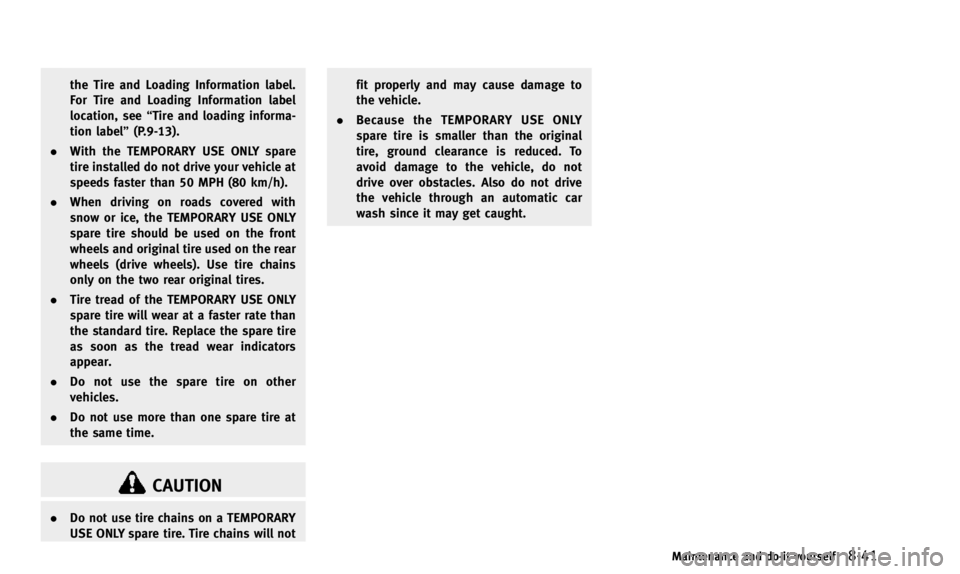
the Tire and Loading Information label.
For Tire and Loading Information label
location, see“Tire and loading informa-
tion label” (P.9-13).
. With the TEMPORARY USE ONLY spare
tire installed do not drive your vehicle at
speeds faster than 50 MPH (80 km/h).
. When driving on roads covered with
snow or ice, the TEMPORARY USE ONLY
spare tire should be used on the front
wheels and original tire used on the rear
wheels (drive wheels). Use tire chains
only on the two rear original tires.
. Tire tread of the TEMPORARY USE ONLY
spare tire will wear at a faster rate than
the standard tire. Replace the spare tire
as soon as the tread wear indicators
appear.
. Do not use the spare tire on other
vehicles.
. Do not use more than one spare tire at
the same time.
CAUTION
.Do not use tire chains on a TEMPORARY
USE ONLY spare tire. Tire chains will not fit properly and may cause damage to
the vehicle.
. Because the TEMPORARY USE ONLY
spare tire is smaller than the original
tire, ground clearance is reduced. To
avoid damage to the vehicle, do not
drive over obstacles. Also do not drive
the vehicle through an automatic car
wash since it may get caught.
Maintenance and do-it-yourself8-41
Page 359 of 394

8-42Maintenance and do-it-yourself
MEMO
Page 360 of 394

9 Technical and consumer information
Capacities and recommended fuel/lubricants....... 9-2Fuel information .............................................. 9-4
Engine oil and oil filter recommendation ......... 9-6
Air conditioning system refrigerant and
lubricant recommendations ............................. 9-7
Specifications ...................................................... 9-8
Engine............................................................. 9-8
Wheels and tires ............................................. 9-9
Dimensions ................................................... 9-10
When traveling or registering your vehicle in
another country ................................................. 9-11
Vehicle identification ......................................... 9-11 Vehicle Identification Number (VIN) plate ....... 9-11
Vehicle identification number
(chassis number) ........................................... 9-11
Engine serial number .................................... 9-12
F.M.V.S.S./C.M.V.S.S. certification label .......... 9-12
Emission control information label ................ 9-12
Tire and loading information label ................. 9-13
Air conditioner specification label.................. 9-13 Installing front license plate .............................. 9-14
Removing air deflectors..................................... 9-15
Vehicle loading information............................... 9-16
Terms .......................................................... 9-16
Vehicle load capacity ................................... 9-17
Loading tips................................................. 9-18
Measurement of weights.............................. 9-18
Towing a trailer ................................................. 9-19 Flat towing................................................... 9-19
Uniform tire quality grading .............................. 9-19
Treadwear .................................................... 9-19
Traction AA, A, B and C................................ 9-20
Temperature A, B and C ............................... 9-20
Emission control system warranty ..................... 9-20
Reporting safety defects.................................... 9-21
Readiness for Inspection/Maintenance (I/M) test
(US only)........................................................... 9-22
Event Data Recorders (EDR) ............................... 9-23
Owner’s Manual/Service Manual
order information .............................................. 9-23